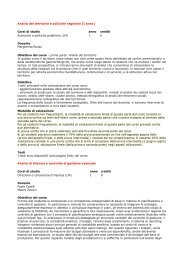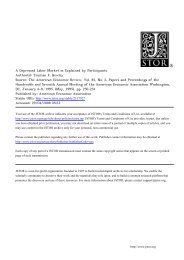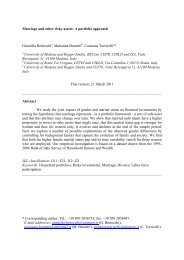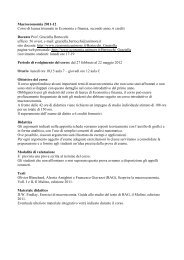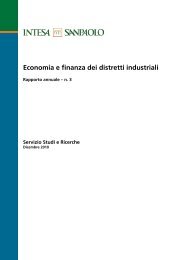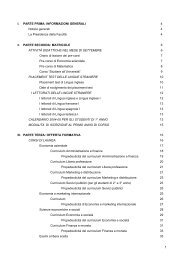(1) the extern<strong>al</strong> environment (e.g. economy, culture, leg<strong>al</strong> matters, <strong>et</strong>c.) of the UKshares more or less similar characteristics with the US, but has very differentcharacteristics from that of China;(2) British consumers have more associations and are more familiar with the USthan with China, as a result of the long history of Anglo-American traderelations; and(3) British consumers are more aware of and knowledgeable about US products, asopposed to Chinese products, because the latter have only recently made theirappearance in internation<strong>al</strong> mark<strong>et</strong>s.US versusChinese goods811Summary and conclusionsOne summary conclusion to be derived from the findings of this study is that consumerev<strong>al</strong>uations of country-of-origin are very complex and sophisticated, since they maydiffer across different levels of an<strong>al</strong>ysis, different product attributes, and differentcountries. With regard to the level of an<strong>al</strong>ysis, our study has shown that at the country,industry, and product levels, consumer ev<strong>al</strong>uations are more or less the same, probablybecause of limited differentiation in the chunks of information used by consumers.However, when it comes to brand, it has a serious moderating role to play, eitherpositive or negative, on country of origin ev<strong>al</strong>uations. This is because, unlike fictitiousor vague brands, every known brand has certain equity d<strong>et</strong>ermined by its popularity,reputation, and associated beliefs in the minds of consumers, thereby providing moreprecise information. In the present case, the high brand equity possessed by Whirpoolwas responsible for elevating further the <strong>al</strong>ready positive image that British consumershave of US goods, while the low brand equity of Haier was conducive to underminingfurther the <strong>al</strong>ready low image of products made in China. However, our study has <strong>al</strong>soshown that brand equity may play a secondary role in country-of-origin ev<strong>al</strong>uations,when consumers are confronted with an actu<strong>al</strong> model of a specific brand. In this case,their judgments can become more accurate and to the point, because of the availabilityof re<strong>al</strong>, hands-on information about the model. The processing of this information byconsumers may result in more favorable (e.g. Haier) or unfavorable (e.g. Whirpool)ev<strong>al</strong>uations, depending on the nature and content of the information provided.Our study <strong>al</strong>so reaffirmed that the country-of-origin construct consists of manydifferent cues (pertaining to product and mark<strong>et</strong>ing issues), each of which may beev<strong>al</strong>uated differently by consumers. This is in direct contrast to studies that have usedcountry-of-origin as a single cue in their an<strong>al</strong>yses, thus producing misleading results.The ev<strong>al</strong>uation of “promotion<strong>al</strong> issues” for US goods, more favorably compared toother categories of cues, is indicative of the long-held, strong mark<strong>et</strong>ing andadvertising practices of US firms on a worldwide sc<strong>al</strong>e, whereas their low ev<strong>al</strong>uationon “pricing considerations” reflects problems associated with the high cost ofproducing goods in industri<strong>al</strong>ized countries. An inverse picture was obtained for goodsmade in China: the lowest ratings received for “promotion<strong>al</strong> issues” denote handicapsin the mark<strong>et</strong>ing and selling abilities of Chinese firms, while the relatively highev<strong>al</strong>uations obtained for “pricing considerations” stress the low-cost productionpossibilities available in less-developed countries. These findings are consistent withthe ev<strong>al</strong>uations received by the remaining cues, in the sense that US goods consistentlyreceived higher scores, denoting b<strong>et</strong>ter design, qu<strong>al</strong>ity, distribution, service, and so on,as opposed to Chinese goods, which received lower ev<strong>al</strong>uations. As a result of this
<strong>EJM</strong>41,7/8812situation, it is not surprising that, in their mark<strong>et</strong>ing campaigns, US firms tend tostress the manufacturing or design origin of their products, as opposed to Chinesefirms, which in many cases try to hide their country-of-origin weaknesses bypurchasing foreign brands, manufacturing their products in countries with a b<strong>et</strong>terimage, or masking the origin of their products.Fin<strong>al</strong>ly, with regard to differences b<strong>et</strong>ween countries, the higher ev<strong>al</strong>uationsreceived by US goods vis-à-vis their Chinese counterparts on <strong>al</strong>most <strong>al</strong>l categories ofcues is indicative of the superiority possessed by developed country-basedmanufacturers on non-price issues. However, this superiority has not beendeveloped overnight, but has come about through the gradu<strong>al</strong> accumulation ofknowledge, expertise, and capabilities. On the other hand, China’s superiority on“pricing considerations” reflects a comp<strong>et</strong>ency in providing manufacturing excellence,economies of sc<strong>al</strong>e, and low production costs. However, Chinese firms are new andinexperienced in internation<strong>al</strong> mark<strong>et</strong>s, and suffer from various mark<strong>et</strong>ing weaknessessuch as:.limited understanding of tastes, preferences, and habits in host countries;.heavy reliance on imitations, rather than on autonomous innovation capacity;.inability to offer pre- and after-s<strong>al</strong>es service to their foreign customers; and.tendency to avoid spending money on advertising and promotion<strong>al</strong> activity tosupport products (Zeng and Williamson, 2003; Schrage, 2004).These are indications of the “nascent” notion ascribed to mark<strong>et</strong>ing by Chineseexecutives, which to some extent can be attributed to the low-risk business traditionand the inward-looking nature of Chinese culture (Dollan and Hardy, 2002). As Gao<strong>et</strong> <strong>al</strong>. (2003) put it, Chinese companies lack the vit<strong>al</strong> mark<strong>et</strong>ing skills required tointroduce and sustain brands in developed mark<strong>et</strong>s, which are characterized byheightened complexity, uncertainty, and expensiveness.Policy implicationsThe findings of this study have sever<strong>al</strong> implications for public and corporatepolicy-makers. Public-policy makers should re<strong>al</strong>ize that country-of-origin ev<strong>al</strong>uationsby foreign consumers are not formulated only at the over<strong>al</strong>l country level, but <strong>al</strong>so atother more specific levels, such as the industry, product, and brand. In fact, our studyhas amply demonstrated that brand image may improve or worsen ev<strong>al</strong>uations madeat the country level. Having this in mind, governments, industry associations, andother parastat<strong>al</strong> organizations should do their best to improve country-of-origin. Thiscould be achieved, for example, by s<strong>et</strong>ting minimum qu<strong>al</strong>ity standards for indigenousmanufacturers, that need to be attained by the provision of various financi<strong>al</strong>, tax, andother incentives. US public policy-makers should capit<strong>al</strong>ize on the favorableev<strong>al</strong>uations given by British consumers to their products, by developing speci<strong>al</strong>communication campaigns in the UK, focusing on such positive attributes as qu<strong>al</strong>ity,service, and availability. These campaigns could include, for example, press releasemateri<strong>al</strong> about US manufacturers and their products, advertising spots appearing inprint and electronic media, and the organization of “US nation<strong>al</strong> days”. On the otherhand, Chinese offici<strong>al</strong>s should try to improve the image of their country on a widerange of non-price issues, such as innovations, qu<strong>al</strong>ity, and distribution, while at the
- Page 1: The current issue and full text arc
- Page 5 and 6: EJM41,7/8790Table I.Authors Study o
- Page 7: EJM41,7/8792Table I.Authors Study o
- Page 10 and 11: in overseas markets, and the adjust
- Page 12: 2002a, b). Products made in countri
- Page 15 and 16: EJM41,7/8800may also create positiv
- Page 17 and 18: EJM41,7/8802Sample profileIn terms
- Page 19 and 20: EJM41,7/8804Table III.Literature so
- Page 21 and 22: EJM41,7/8806Table IV.Confirmatory f
- Page 23 and 24: EJM41,7/8808Table VI.A comparison o
- Page 25: EJM41,7/8810Table VII.A multi-level
- Page 29 and 30: EJM41,7/8814based on their previous
- Page 31 and 32: EJM41,7/8816Bannister, J.P. and Sau
- Page 33 and 34: EJM41,7/8818Kaynak, E. and Kara, A.
- Page 35: EJM41,7/8820Tse, D.K. and Gorn, G.J






